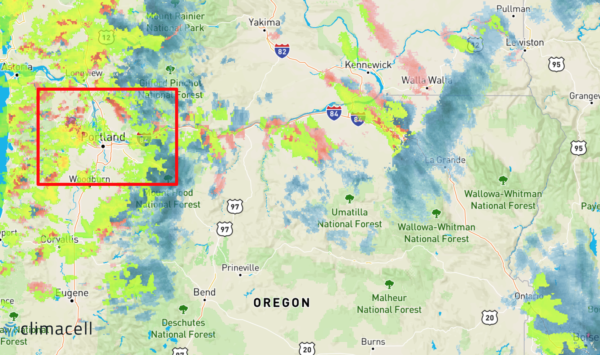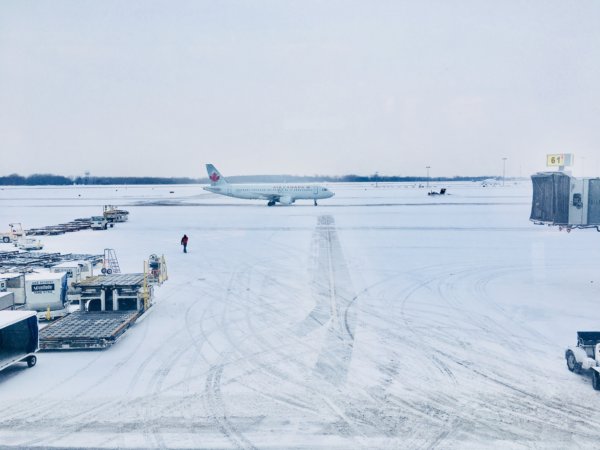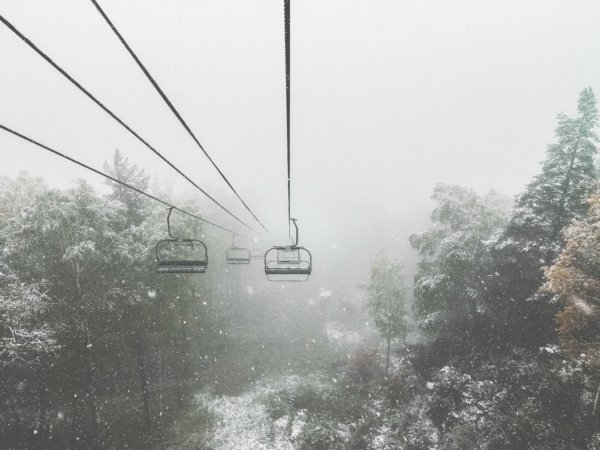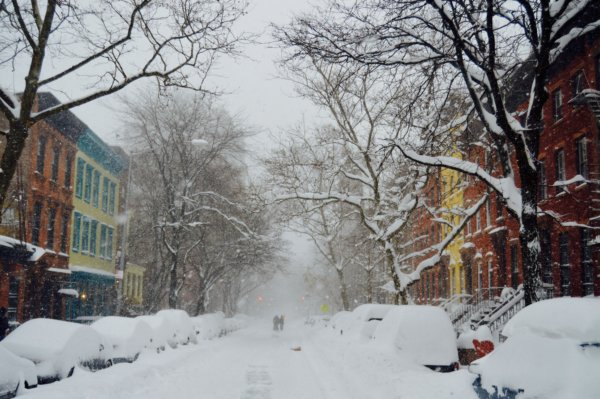Winter chaos is officially upon us. Consider the Pacific Northwest right now for example as they prepare for a week of extreme weather in the form of cold air and major snowfall.
While most states will be hit hard in the coming days, places like Portland, OR are already starting to feel the effects of the sweeping storm.
This type of winter weather has obvious impacts on people in the region, from needing to bundle up to shoveling out cars, and then of course the ski and snowboard crowds who can’t wait to hit the slopes.
But what about the impact of snow on businesses?
What does it mean for businesses when the forecast calls for multiple feet of snow seemingly out of nowhere? Consider these two data points:
- Weather variability as reported by Harvard Business Review comes with serious cost, to the tune of more than $630B just in the United States!
- More than 70% of businesses say abnormal weather disrupts their operating and financial performance every year.
The general takeaway here is most businesses are being hugely impacted by variable weather. What’s worse? Most businesses find out about upcoming weather at the same time everyone else does and are often times left surprised and unprepared, and with the increase in weather events each year around the globe, this type of abnormal weather has the potential to cripple unsuspecting businesses.
As a business, however, what can you really do about this type of winter weather? You certainly can’t stop it from coming, but you can plan for it and actually use it to your operational advantage, which is where the biggest opportunity is for businesses today to take control.
Planning for Wintry Weather
A few industries heavily impacted by winter weather include transportation, retail, sports and outdoors, technology and on-demand, aviation, construction, and energy. If left to chance, unsuspecting weather activity will wreak havoc on businesses across all of these industries. But what’s the secret to planning for and managing chaotic weather conditions? The answer isn’t only being prepared, but having an automated insights and action plan in place, and the businesses that do will be the ones to realize the most impactful operational and financial gains while also keeping their customers and employees safer. Using these industries as an example, what should businesses include in their preparedness and action plan? Anything and everything.
Let’s look at a few examples by industry and we’ll use snowfall as the type of weather impact in honor of our Pacific Northwest friends this week.
1. Aviation: This industry includes regional airports, centralized airport headquarters, airlines…etc.
In reacting to snowfall, some of the most impacted operations are:
- Runway conditions: With heavy snowfall, airports need to ensure that runways are clear and safe for airplane traffic. Knowing which runways need to be cleared and when can make a significant difference in planning.
- Staffing needs: From snow plows and salt trucks to janitorial services, shift management needs spike across both the airports and airlines, and knowing those needs ahead of time decrease the risk of being short staffed.
- Flight delays: The one thing airport goers fear the most! Snowfall inevitably causes flight delays, as planes may need to be deiced or runway conditions are causing delays. airlines are constantly at risk of delays during heavy snowfall. The more you can plan ahead the better, for instance if you know you’re going to need to deice planes 12 hours from now given incoming snow you can make those arrangements ahead of time to ensure you’re being as operationally efficient as possible.
2. Construction: This industry includes paving companies, roofing companies, general contractors…etc.
A few examples of how snowfall can impact the construction industry include:
- When to pave roads: Paving is a tricky business. For the most part, businesses can’t pave in freezing or wet conditions, so no paving this week in the Pacific Northwest! But what if the weather hadn’t called for any precipitation so you sent your paving crews out and then all of a sudden a snow storm hit that you didn’t know about? Shift time and money wasted.
- Roofing work: The ideal temperature for roofing is above 40 degrees fahrenheit, but what if a cold front hits that you didn’t know about or weren’t tracking? Again, time and money wasted from staffing to materials to unhappy customers.
- Construction: While snowfall and freezing temperatures can take a toll on construction jobs including frozen grounds, concrete installation, and cracking electrical wire casing, even simple tasks will just take longer if you’re not prepared, not to mention employee safety. For instance, if the temperature is below a certain point it will be unsafe for crews to work, but if they aren’t notified ahead of time and come to work then both time and money will be wasted when they show up only to be sent back home.
3. On-Demand Technology: The on-demand industry includes businesses involved in delivery, transportation, doing various home and consumer jobs or tasks…etc
A few examples of how snowfall can impact businesses in the on-demand industry include:
- Food delivery: For on-demand food delivery businesses, heavy snow means people are staying home and ordering in. Restaurants in fact report seeing 20% or more of a decline in business during extreme weather events, which is why many of them turn to the delivery companies to bolster revenues and offer delivery. This will mean a huge spike in the number of drivers the business needs to staff in order to offer realistic wait times for consumers and restaurants. If you’re not prepared ahead of time to staff up more drivers, you’ll be scrambling in real-time and lose out to better prepared competitors.
- Overall employee safety: On-demand businesses employ people who often need to be outdoors or driving in order to do their job. While it’s great to have these types of services as a consumer during extreme weather events, safety comes before all else. A well prepared on-demand company should be able to warn their people of freezing temperatures or even more incoming weather that may put them at risk.
- Equipment management: For on-demand companies operating equipment in the outdoors, such as drones for instance need to be ahead of the weather or they risk expensive damage. Freezing temperatures, snow, high winds can easily damage equipment, and knowing ahead of time what the exact conditions will be can inform your decisions to send equipment out into the elements or not – which can make a significant difference on your operational procedures and bottom line.
4. Sports and Outdoor: Sports, festivals, ski mountains and more – the very nature of this industry means weather related issues, especially in the snow!
A few examples of how snow impacts the sports and outdoor industry include:
- Sports stadiums: Being ahead of the weather makes all the difference for sports stadiums. By knowing when and where snowfall will hit, you can implement necessary protocols quicker rather than reacting on the fly and increasing safety risks and operational inefficiencies. Stadiums that know snow is coming in advance can pre-staff their snow crews for shoveling, plowing, and making sure the sidewalks aren’t icy. They can deal with field, vendor, and fan related issues and ensure their staff is all aware of the changes needed given the weather, which will be different if the expected snowfall is 6 inches or 2 feet!
- Ski mountains: For any snow mountain that makes its own snow, it’s vital to know when and how much it’s going to snow and how the wind will impact the snowfall. Snow making needs will directly depend on this in addition to the temperature, but being able to accurately understand how snowfall is going to impact the mountain and the people on it beforehand means you can have pre-planned protocols ready to implement and save time and money.
- Sports teams: For any team or individual competing in snowy conditions, strategy strategy, strategy. You simply can’t employ the same strategy that you would on a warm sunny day with no wind. That said, being ahead of the weather and/or knowing how it will impact certain strategies can give teams and individuals a unique competitive advantage. For instance, what if you knew exactly how much snow would be on the field, how the wind might shift over the course of 4 hours or even how much the temperature will fluctuate? Depending on the results and how those results would impact performance, your strategy would change.
5. Energy: This industry includes businesses across energy and power companies, utilities, gas…etc
The most top of mind “energy” examples given heavy snow comes from the power companies since everyone is most worried about losing power, and a few of the ways for power companies to be best prepared include:
- Preparing customers: The earlier power companies know about incoming snow, how much is going to fall, for how many hours or days…etc, the sooner they can be prepared and send out customer communications on anticipated power outages and their operational plans, which increases customer satisfaction and safety.
- Internal safety protocols: With so many employees on the roads fixing electricity issues safety becomes a huge concern. Freezing roads, slippery conditions, falling ice and everything else mother nature can throw, employees need to be notified of what to expect and what protocols to employ so they’re not left guessing or unprepared.
- Staffing needs: Have you ever seen a snow forecast where they said it was going to fall 1 – 3 feet? It’s hard to plan for staffing needs with that much of a fluctuation and range. If it snows 12 inches staffing needs will be X, but if it snows 36 feet staffing needs will be Y. Knowing how much snow will fall ahead of time allows you to staff up in the right areas of your business instead of reacting in the fly because you didn’t have the right protocols in place.
The 4 Secrets to Implementing a Winter Weather Strategy
In order to be truly prepared for abnormal winter weather you need to focus on a few key operational areas:
- Have the right information: First, you need the right information for your hyperlocal area. The forecast for your entire state or region isn’t enough, you need to know exactly how the weather is going to impact your exact location and for how long. You should be planning your business around the weather, and giving yourself as many days as possible to be ahead of the weather from s strategy standpoint
- Apply the most impactful insights: Once you can trust and truly rely on hyperlocal weather information, now you can start to consider what that information means for you and develop insights for your business. For instance, if you own a ski mountain or a stadium you might need to staff up if a winter storm is going to deliver more than 12 inches of snow, and you need to know the exact time and duration of a given storm so you can continue to staff properly. Or, you may run operations for an airline, and if the weather is going to drop below a certain temperature then various protocols need to be taken to ensure airplane safety.
- Implement an automated action plan: Now that you have your weather information and insights into how certain weather conditions impact your business, it’s time to prepare for action. Using the airline example, you can now set-up protocols across your team and automatically alert people when the temperature is going to drop below a certain point, and the actions that need to happen. Of course the faster you’re notified of incoming weather the better, allowing your team to get their plans ready and reduce the impact on your business. By the way, did you know every minute an airline is delayed costs roughly $75? Every. Minute. Counts.
- Ensure team collaboration: When you have weather events, teams need to collaborate and work together more than they would on a normal day. That means meetings, emails, texts, questions, and confusion. Being prepared ahead of time will reduce the amount of human error and emotion during stressful and abnormal periods of time.
Implementing a Weather Plan of Your Own
We hope you found these examples helpful, wintry weather and abnormal weather unapologetically throws wrenches into business operations. As you can see from the examples given here, having a plan is the most important thing you can do. Implementing a pre-defined and agreed upon strategy vs. reacting to weather is night and day for your business and team. It saves you time, money, decreases safety concerns, and increases efficiency and customer satisfaction.
If you don’t have perfect operational procedures for abnormal weather, you’d like to learn more about how to plan for your own business, or you’d simply like to get some feedback on your existing weather operations strategy we’d love to talk to you! Our weather operations experts specialize by industry to ensure we can provide you with deep expertise and actionable insights.














